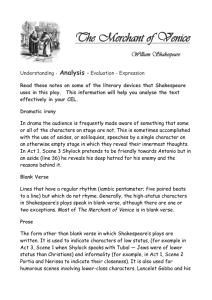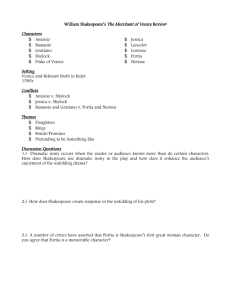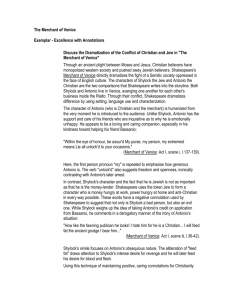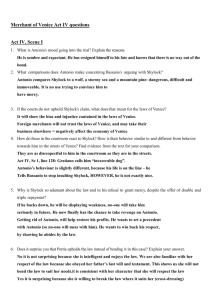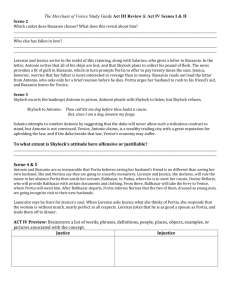The Merchant of Venice
advertisement
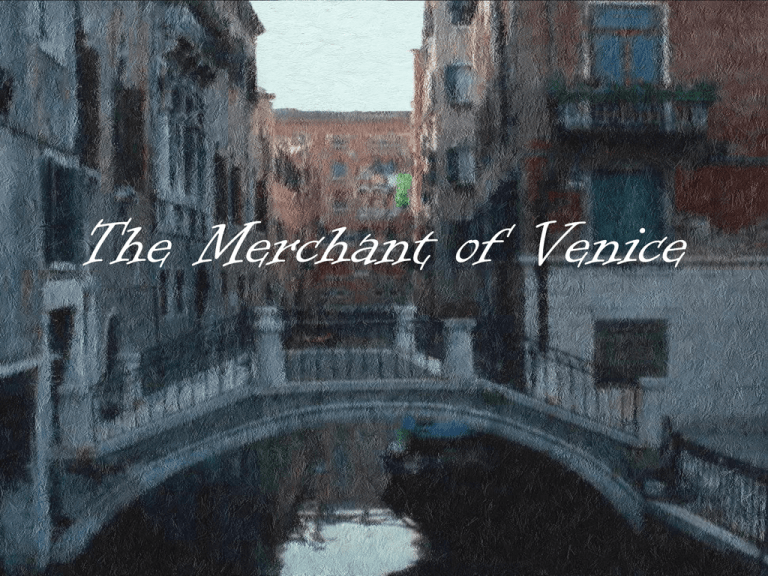
The Merchant of Venice Settings • The action takes place in Venice, Italy, and Belmont, the site of Portia’s estate. Venice (Venezia) is in northeastern Italy on the coast of the Adriatic Sea. • In late medieval and early Renaissance times, Venice was one of Europe’s greatest centers of commerce. Dates, Sources, and Type of Play • Date Written: About 1596 • Probable Main Sources: Il Pecorone (1378), by Giovanni Fiorentino; Gesta Romanorum (Latin, 13th Century); oriental tales; the Jew of Malta, by Christopher Marlowe (1564-1593) • Type of Play: Although the play is considered a comedy, it is probably better categorized as a tragicomedy (a play with both comic and tragic elements). Anti-Semitism in England • Prejudice against Jews increased in England around 1190 after non-Jews borrowed heavily from Jewish moneylenders, becoming deeply indebted to them. • In York, about 150 Jews committed suicide to avoid being captured by an angry mob. • King Richard I (reign: 1189-1199) put a stop to Jewish persecution, but it returned in the following century during King Edward I's reign from 1272 to 1307. • The government required Jews to wear strips of yellow cloth as identification, taxed them heavily, and forbade them to mingle with Christians. Anti-Semitism in England • Finally, in 1290 Edward banished them from England. Only a few Jews remained behind, either because they had converted to Christianity or because they enjoyed special protection for the services they provided. • In Shakespeare's time 300 years later, anti-Semitism remained in force and almost no Jews lived in England. Christopher Marlowe, a contemporary of Shakespeare, wrote a play entitled The Jew of Malta, which depicted a Jew named Barabas as a savage murderer. Shakespeare, while depicting the Jewish moneylender Shylock according to denigrating stereotypes, infuses Shylock with humanity and arouses sympathy for the plight of the Jews. Use of Disguises • Time and again, Shakespeare disguises women as men to further a plot. • In each of these plays, the women disguised as men eventually reveal their true female identities. All of this could have been quite confusing to playgoers in Shakespeare's day, for only men played women's roles. Thus, in the abovementioned plays, men played women disguised as men who at some point doffed their male identities to reveal themselves as females. Themes • Theme 1: Jews suffer bigotry and other forms of mistreatment because of their religion and race. • Theme 2: Friendship requires sacrifice. • Theme 3: Revenge ultimately destroys its perpetrator. • Theme 4: Appearances are deceiving. • Theme 5: Women can be just as competent as men, maybe even more so. • Theme 6: Women can be just as ruthless as men, maybe even more so. • Theme 7: Don't count your ships until they're in port. • Theme 8: Great wealth and privilege breed apathy and disquietude. Themes • Theme 1: Friendship requires sacrifice. Antonio risks his fortune-and later his life--to help Bassanio win Portia. Tubal lends Shylock the 3,000 ducats requested by Antonio. • Theme 2: Appearances are deceiving. Neither the gold nor the silver casket contains the key to winning Portia. Instead, it is the plain lead casket. Shakespeare expresses this theme--appearances are deceiving--in a message inside the golden casket. It says, "All that glitters is not gold." The latter quotation can also apply to characters who tie their happiness, destiny, or status to money, including Antonio, Bassanio, and Shylock. • Theme 3: Revenge ultimately destroys its perpetrator. Shylock seeks revenge against his enemies, but it is he who suffers the downfall after Christians unite to trick him. Perhaps he would have had more success if he had pursued justice instead of revenge. Themes • Theme 4: Jews suffer bigotry and other forms of mistreatment because of their religion and race. Christians alienate Shylock simply because he is a Jew. In ancient, medieval, and Renaissance times, Jews almost always encountered prejudice from non-Jews around them. Scholars are divided on whether Shakespeare, in The Merchant of Venice, was attempting condemn anti-Semitism by sympathizing with Shylock or approve of anti-Semitism by ridiculing Shylock. It may well be that Shakespeare was simply holding a mirror to civilization to allow audiences to draw their own conclusions. • Theme 5: Women can be just as competent as men, maybe even more so. Portia, disguised as a man, speaks eloquently in defense of Antonio and persuades the Duke of Venice to rule in Antonio's favor. Themes • Theme 6: Women can be just as ruthless as men, maybe even more so. Portia, who lectures Shylock and the court on the importance of mercy, exhibits racism after she rejects the Prince of Morocco because he is black. Moreover, she cleverly tricks and ruins Shylock without showing a hint of remorse. • Theme 7: Don't count your ships until they're in port. Antonio confidently pledges the merchandise on his ships at sea to repay Shylock's loan to Bassanio. But all the ships are wrecked before they reach Venice. • Theme 8: Great wealth and privilege breed apathy and disquietude. In the opening line of the play, Antonio says, "In sooth, I know not why I am so sad." Then, in the first line of Act I, Scene II, Portia expresses a similar sentiment: "By my troth, Nerissa, my little body is aweary of this great world." Nerissa, Portia's servant, understands what the privileged classes cannot understand: "They are as sick that surfeit with too much as they that starve with nothing." Debate • Does Shakespeare, in The Merchant of Venice, attempt to condemn antiSemitism by sympathizing with Shylock or approve of anti-Semitism by ridiculing Shylock?
